#JAPAN AKADEMIE DER KÜNSTE
Text
20230409 Disziplin....
20230409 DISZIPLIN“Discipline is not a mystery. It’s the simple and dedicated practice of aligning your vision with your actions.”The statement is quite accurate. Discipline is all about consistently aligning your actions with your goals and vision. It is not a mystery or something that only a select few possess. Rather, it is a skill that can be developed through consistent practice and…

View On WordPress
#2023#@PHOTOGRAPHIE BY NORBERT WEBER#APRIL#BUSHIDO#DISZIPLIN#JAPAN AKADEMIE DER KÜNSTE#KARATE-DO#NORBERT WEBER KARATELEHRER#PHOTO-ART-WEBER#SAMURAI
7 notes
·
View notes
Photo
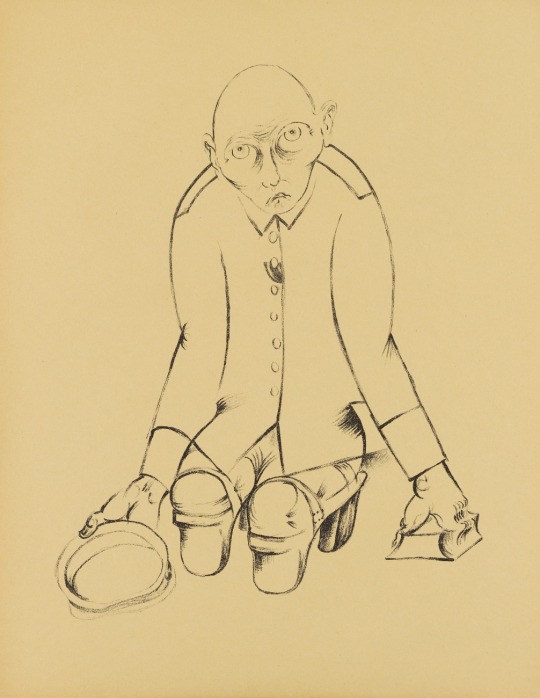
Heinrich Hoerle Krüppel (Die Krüppelmappe) 1920 Series of 12 lithographs. Each on firm brownish paper 58.9 x 45.8 cm. - Together with title sheet loosely laid in original half-linen portfolio 64.4 x 49.5 cm with collage of the title motif "Krüppel" (Backes 16) as a linoleum cut on Japan paper 16.8 x 12.2 (23 x 17.3 cm) Unsigned. The title sheet with index and colophon numbered in pencil. Copy 92/100. - Rare. Published by the artist "Heinrich Hoerle, Cöln-Lindenthal", Cologne 1920. - The sheets with minimal traces of age. The thinner title sheet (simili Japan) with a minor defect in the upper margin and backed with paper strips verso. The portfolio slightly wavy with pressure marks. Following the brochure for the 1920 edition of “Krüppel“, published by the artist, it seems a total edition of 300 copies with hand-signed lithographs was planned, 50 of which were printed on Japan laid paper with an original colour drawing as the title page. However, there are unsigned series on simpler, heavier types of paper, featuring an edition numeration of 100 in the colophon. The "Krüppelmappe" is one of the artist's early expressionist masterpieces. Probably designed at the end of 1919, it is not only a critical contemporary commentary on the social misery of those disabled in the war - in the "Sozialistischen Republik" of 30.01.1920, Franz Wilhelm Seiwert published a contribution to the first exhibition of the portfolio in Cologne under the title "Krupp-Krüppel" - it also sensitively reflects the deeply human and emotional aspects of physical mutilation in the artistic sequence of the various pictures. Otto Dix continued the theme in the large-format painting "Die Kriegskrüppel", among others, from the same year, formerly in the Stadtmuseum Dresden, confiscated in 1937 and lost since then (cf. Löffler 1920/8 with illus., cf. also the etching of the same name Karsch 6). Catalogue Raisonné Backes Druckgraphik 16, 17 Certificate We would like to thank Dirk Backes, Aachen, for kind scientific advice. Provenance Private possession, Rhineland Literature Die Aktion. Wochenschrift für Politik, Literatur und Kunst, Berlin 1920, 10th year, with illus.; a bis z, organ der gruppe progressiver künstler, Cologne, Dec. 1931, issue no. 20 with illus.; Walter Vitt, Heinrich Hoerle und Franz Wilhelm Seiwert. Die Progressiven, Cologne 1975, p. 19 with illus.; U. Bohnen, Das Gesetz der Welt ist die Änderung der Welt. Die rheinische Gruppe progressiver Künstler (1918-1933), Berlin 1976, no. 8 with illus. p. 27 Exhibitions Cologne January 1920 (Lichthof des Kunstgewerbemuseums); Moscow 1924 (Erste allgemeine Deutsche Kunstausstellung); Frechen 1970/1971 (Kunstverein Frechen e.V.), Hoerle und sein Kreis, cat. no. 154 with illus.; Cologne 1975 (Kölnischer Kunstverein), Vom Dadamax zum Grüngürtel - Köln in den 20er Jahren, n. cat. no., with illus. p. 100/101; Berlin 1975 (Akademie der Künste Berlin/ Neue Gesellschaft für Bildende Kunst), Politische Konstruktivisten. Die "Gruppe progressiver Künstler" Köln 1919-1933, with illus.; Cologne 1980 (Kölnischer Kunstverein), Max Ernst in Köln. Die rheinische Kunstszene bis 1922, cat. no. 165 with illus. https://www.lempertz.com/en/catalogues/lot/1110-1/436-heinrich-hoerle.html
5 notes
·
View notes
Text
Old Vienna
Rudolf Hausner

* 4. Dezember 1914 Wien 9, Rögergasse, † 25. Februar 1995 Wien (in seiner Wohnung; Zentralfriedhof, Ehrengrab, Gruppe 33G, Nummer 4), Maler, erste Gattin (1942) Grete Czingely, zweite Gattin (1944) Irene Schmied, dritte Gattin (1951) Hermine Jedliczka, vierte Gattin Anne Wolgast.
Studierte 1931-1936 an der Akademie der bildenden Künste, wandte sich dem Expressionismus zu und wohnte ab 1936 in einer Mansarde des Hanuschhofs (Selbstporträt mit blauem Hut [Österreichische Galerie; Prototyp des "Adam"]; zwei Gassenbuben [1937; Historisches Museum der Stadt Wien], erstmaliges Auftauchen des Narrenhuts). 1938 erhielt er Ausstellungsverbot, 1941 wurde er zum Kriegsdienst eingezogen und 1943 in die Rüstungsindustrie abkommandiert. Nach dem Krieg schloss er Freundschaft mit J. M. Hauer, dem Kritiker Johann Muschik und dem Psychiater Hans Strotzka. 1946 gründete Hausner eine surrealistische Gruppe (während der ersten Ausstellung im Konzerthausfoyer kam es zu Publikumsprotesten), international (Ausstellungenen in Nord- und Südamerika, Japan) erzielte Hausner jedoch beachtliche Erfolge.
Seine Gemälde "Anima" (1947), "Forum der einwärts gewendeten Optik" und "Ich bin Es" (1948) sowie die "Arche des Odysseus" (1951-1956; Historisches Museum der Stadt Wien) machten ihn berühmt.
Der Bruch mit der Orthodoxie bedeutete die Geburt der "Wiener Schule des Phantastischen Realismus" (erste Gruppenausstellung 1959 im Oberen Belvedere). Hausner befreundete sich mit René Magritte, Paul Delvaux und Viktor Brauner. Der Berufung nach Hamburg folgte eine an die Akademie der bildenden Künste. Innerhalb der Schule des Phantastischen Realismus war Hausner der zurückhaltendste und am wenigsten kommerzialisierte Repräsentant; er selbst sah sich als "psychischen Realisten", er war mehr Analytiker als Phantast und untersuchte in den "Adam-Bildern" sein eigenes Ich.
Hausner erhielt auch städtische Aufträge (Antike Badeszene, Theresienbad, 1953; Hauszeichen, 2, Vorgartenstraße 55, 1954; Billroth-Mosaikwandbild, 19, Billrothstraße 77, 1955/1956; Fußballer-Mosaikwandbild, 16, Zwinzstraße 15-21, 1956; Mosaikwandbild, 14, Heinrich-Collin-Straße, 1957/1958; Der Raum, in dem wir leben, 21, Justgasse, 1962/66; Ölbild für das Sportheim 10, Nothnagelplatz, 1964/1967).
1965 wurde Hausner Gastdozent, 1966 Professor an der Hochschule für bildende Künste in Hamburg, 1968 an der Akademie der bildenden Künste in Wien. 1969 übersiedelte er nach Hietzing, 1972 in die Hinterbrühl.
Burda-Preis München (1967), Preis der Stadt Wien (1970), Österreichischer Staatspreis für Malerei (1970).
1. 1990, Veranstaltung (Karmeliterhof)
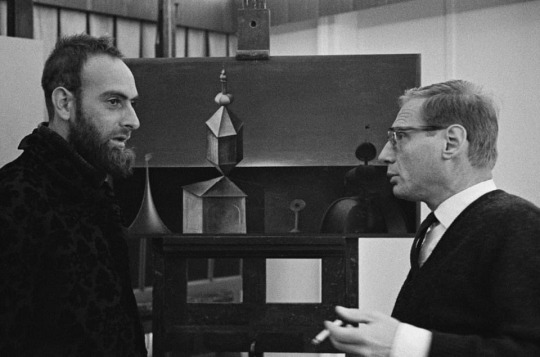
2. 1962, Friedensreich mit Hundertwasser

3. 1961, Künstler im Atelier Foto: Mejchar, Elfriede, 1924-2020
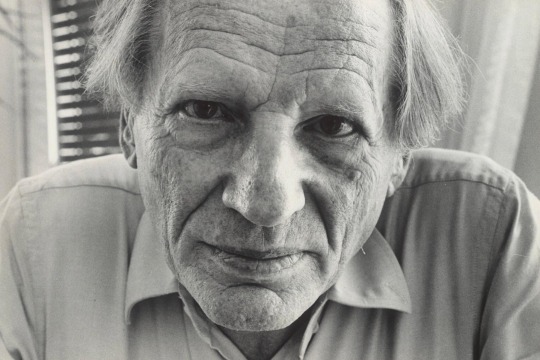
4. 1983, Bildnis des Künstlers auf seinem Anwesen in Mödling

5. Ehrengrab, Zentralfriedhof, Gruppe 33G
0 notes
Text
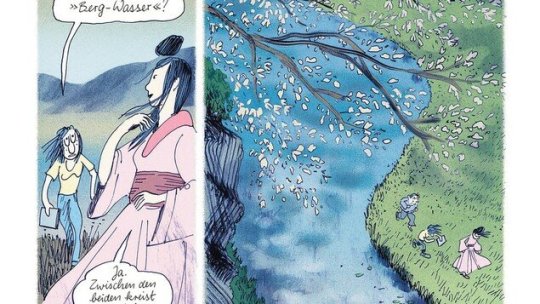
Die reduzierte Ästhetik japanischer Farbholzschnitte und der Kalligrafie trifft auf den dynamischen Kritzelstrich der frankobelgischen Funny-Comics und die üppige Bildsprache der traditionellen europäischen Malerei: In „Nami und das Meer“ ( Kolorierung Isabelle Merlet, Übersetzung Ulrich Pröfrock, Carlsen, 114 Seiten, 22 Euro.), dem neuen Buch der einstigen „Charlie Hebdo“-Zeichnerin Catherine Meurisse, ist der Kulturaustausch nicht nur ein die Handlung strukturierendes Leitmotiv. Die 42-Jährige kombiniert in ihrer Bilderzählung auch die künstlerischen Techniken der beiden Welten, die sich bei ihr begegnen.
Das Titelbild des besprochenen Bandes.Foto: Carlsen
Hauptperson ist eine als Strichfigur gezeichnete und offensichtlich der Autorin nachempfundene europäische Künstlerin, die für ein Residenzprogramm nach Japan reist. Dort begegnet sie heimischen Künstlern, sprechenden Fabeltieren und am Ende eines bewusstseinserweiternden Ausflugs auch ihrer eigenen Geschichte.
In oft humorvollen Dialogen tauscht sich die Besucherin mit ihren Gesprächspartnern über das Verhältnis des Menschen zur Natur und zur Kunst aus. Meurisse, die 2020 als erste Comiczeichnerin in die französische Akademie der bildenden Künste aufgenommen wurde, hat sich in letzter Zeit wiederholt mit diesen Themen befasst.
Nach dem Anschlag auf „Charlie Hebdo“, den sie 2015 durch einen Zufall überlebte, wurden die Schönheit, die Natur und die Kultur für sie Gegenpole zum Chaos und zur Gewalt, die viele ihrer Freunde aus dem Leben gerissen hatten. Davon hat sie sie 2016 in „Die Leichtigkeit“ und 2019 in „Weites Land“ erzählt. In „Nami und das Meer“ wird das Thema weiter vertieft und durch ihre Auseinandersetzung mit dem japanischen Blick auf die Welt erweitert. Das nimmt im Laufe der Geschichte zunehmend märchenhafte Züge an. Durch die Begegnung mit dem rätselhaften Fräulein Nami wird aus einem Landausflug eine spirituelle Reise zum Wesen der Kunst und zu sich selbst.
[2019 hat Tagesspiegel-Autor Ralph Trommer Catherine Meurisse zu ihrer Arbeit und dem Weg zurück ins Leben nach dem Anschlag auf „Charlie Hebdo“ interviewt, hier finden Sie seinen Text.]
Dafür hat Meurisse frei und mit erfrischender Selbstironie den Roman „Das Graskissen-Buch“ des Schriftstellers Natsume Soseki adaptiert, der von der Sinnsuche eines jungen Malers erzählt und als Schlüsselwerk der japanischen Moderne gilt. Im Kunstmuseum Erlangen würde kürzlich eine vom Cartoonmuseum Basel übernommene Retrospektive mit Meurisses Werk eröffnet. Die Schau ist bis zum Internationalen Comic-Salon (16.–19. Juni) zu sehen.
0 notes
Text

Blick ins Atelier
von Karolin Bräg in München und anderswo
Virtuell besuchen wir Kunstschaffende, die mit dem Museum verbunden sind, in ihren Ateliers. Es interessiert uns, woran sie gerade arbeiten, was sie beschäftigt und wie sie ihre Arbeit strukturieren.
Karolin Bräg (*1961) ist mit ihrer Arbeit «Du berührst mich» von 2018/2020 an unserer Ausstellung «MEMORY. Über die Erinnerung und das Vergessen in ungewöhnlichen Zeiten» (Kunstmuseum Olten, 23.1.–18.4.2021) beteiligt. Die Schau kombiniert aktuelle Projekte von Kunstschaffenden, die sich mit der Erinnerung, aber auch dem Vergessen auseinandersetzen mit ausgewählten Werken aus der Museumssammlung.
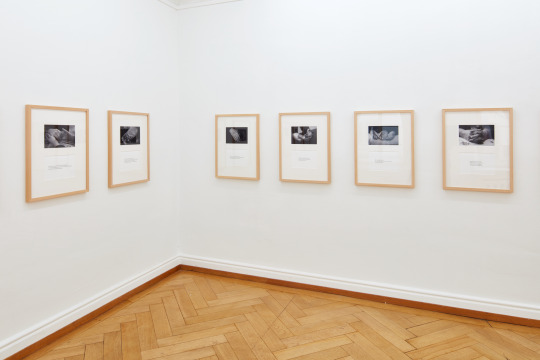
Karolin Bräg: Du berührst mich, 2018/2019
12 Fotografien und Texte aus grösserer Serie, je 17.4 x 26 cm
Ausstellungsansicht Kunstmuseum Olten, 2021
Fotos: Kaspar Ruoff
Katja Herlach (stv. Direktorin) hat Karolin Bräg ein paar Fragen gestellt und sie gebeten, uns Einblick in seine Arbeitsstätte und in die Entstehung ihrer neusten Arbeiten zu geben. Wissen wollte sie auch, welche Rolle die Erinnerung für sein Schaffen hat:
Antworten der Künstlerin
1 Liebe Karolin, wie geht es Dir heute?
Es geht mir gut, denn nächste Woche beginne ich mit den ersten Gesprächen im Kanton Thurgau und ich freue mich auf die Begegnungen.
2 Was hat die Corona-Krise für Dich verändert? Was wird aus dieser Zeit in Erinnerung bleiben?
Corona hat vieles verändert. Die Sorglosigkeit, sich überall hinzubewegen, ging verloren. Die Selbstverständlichkeit, alles ist machbar, ist einer Unsicherheit gewichen: «Was bringt die Zukunft?» Viele Künstler haben von einem Tag auf den anderen ihren Broterwerb und ihr Publikum verloren. In diesem STOP sehe ich aber auch eine Chance zum Nachdenken, zum Umdenken, zum Neudenken. Wir können eine Zukunft entwickeln, in der wir achtsamer mit unseren Ressourcen umgehen. Dieser Virus zeigt uns – wir sind alle miteinander verbunden. In dieser neuen Form von Gemeinschaft spüre ich mehr Verantwortung für mein Handeln.
3 Wie sieht Dein Arbeitsort aus?
Mein Arbeitsort ist mal gross und mal klein, mal hier und mal dort. Zu Beginn einer neuen Gesprächsarbeit verlasse ich meinen gewohnten Umraum. Ich gehe an spezifische Orte und frage mich: «Was macht diesen Ort aus?» In der Fremde werde ich dünnhäutiger, durchlässiger, alles ist neu, unbekannt, anders. Ich lasse die Umgebung auf mich wirken. Später kehre ich nach Hause zurück. Hier ist es plötzlich klein, ein Raum, in den ich mich zurückziehe, die Enge suche und darin die Konzentration finde.
4 Woran arbeitest Du gerade?
Gerade bereite ich meine nächste Reise vor. Der Regierungsrat des Kanton Thurgau will ein Zeichen setzen, das an die fürsorgerischen Zwangsmassnahmen und Fremdplatzierungen vor 1981 und an die Medikamententests in der Psychiatrischen Klinik Münsterlingen zwischen 1940 und 1980 erinnert.
Das Zeichen darf ich auf dem ehemaligen Spitalfriedhof in Münsterlingen realisieren. Doch erst durch die Teilhabe vieler Menschen entsteht das von mir entworfene «Haus der Erinnerungen». Dafür werde ich mehrmals im Thurgau sein und ermutige alle, die Anteil am Zeichen der Erinnerung nehmen, sich einzubringen.


Spitalfriedhof Münsterlingen: Die Künstlerin beim Augenschein & Modell für das Haus der Erinnerungen
5 Aktuell bist Du mit einem Werk in unserer Ausstellung «Memory. Über die Erinnerung und das Vergessen in ungewöhnlichen Zeiten» beteiligt. Kannst Du diese Arbeit ganz kurz vorstellen?
Im Juli 2017 hörte ich von den Menschen, die Beeindruckendes in ihrer Begleitung und Betreuung von Angehörigen mit Demenz leisten.
Frau Dr. Kotulek, Fachreferentin für Demenz vermittelte mir die Kontakte. Die Treffen fanden im Café, bei ihnen Zuhause oder im Heim statt. Alle Gespräche orientierten sich an der Frage: «Was gibt mir die Kraft, für den Angehörigen mit Demenz da zu sein – und was nimmt mir die Kraft?»
Mit 25 Menschen habe ich mich unterhalten. Für ein Foto bat ich jeden, die Beziehung zum Angehörigen mit einer Geste ihrer Hände auszudrücken. So entstanden zunächst Einzelportraits, die in meiner fertigen Arbeit ein facettenreiches Gesamtbild formen, in dem aufscheint, dass diese verantwortungsvolle Aufgabe die Würdigung und Unterstützung der Gemeinschaft verdient.
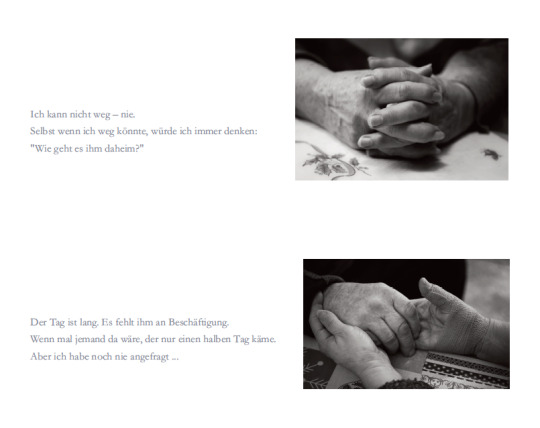
6 Wenn Du Dich zurückerinnerst, an den Anfang des Entstehungsprozesses dieses Werks, kannst Du uns dann etwas darüber sagen, wie Deine Ideen / Projekte entstehen? Wo Du Inspiration findest? Oder wie Du Dich für ein Thema, ein Konzept oder eine spezifische Umsetzung entscheidest?
Es sind die Menschen und der Ort, die mir eine Frage stellen. Sie inspirieren mich, machen mich neugierig. Was passiert in deren Leben? Ich lasse mich berühren. Das Thema findet mich. Wenn ich dann die nötige Unterstützung erfahre, gebe ich alles. Mein Konzept dient der offenen Auseinandersetzung mit den Menschen, ihren Bildern und Vorstellungen, frei von Wertungen.
7 Wie würdest Du Deinen Werkprozess beschreiben?
Gespräche sind Kern und Ausgangspunkt meiner künstlerischen Arbeit. Erst durch die Teilhabe der Mitmenschen kann ein Werk gelingen. Im Gespräch suche ich die gemeinsame Sprache, das Verbindende wie auch das Trennende. Ein Moment des Vertrauens ist notwendig. Es beginnt mit einer ausgewählten Frage, die ich allen in der persönlichen Begegnung stelle, nehme mir Zeit, zeichne nichts auf, mache mir nur ab und zu Notizen, die mich berühren und gewinne im Verlauf immer tiefere Einblicke. Das Gespräch und die Notizen bleiben vertraulich. Aus jedem Gespräch entnehme ich ein oder mehrere Zitate, ohne sie der jeweiligen Person sichtbar zuzuordnen. Es entstehen kurze Sätze, in denen sich die Essenz des Gesprochenen verdichtet. In einem längeren Prozess fügen sich die Gesprächsfragmente zu einem Gesamtbild und es findet sich die künstlerische Form, um das Gehörte und Gesammelte sichtbar zu machen. Auf der einen Seite das persönliche Gespräch mit wenigen Gesprächspartnern, auf der anderen Seite der lesende Betrachter. Erst wenn sich die fragmentierten Sätze mit den eigenen Erfahrungen und der persönlichen Geschichte verbinden, entfalten sie ihr Potenzial.


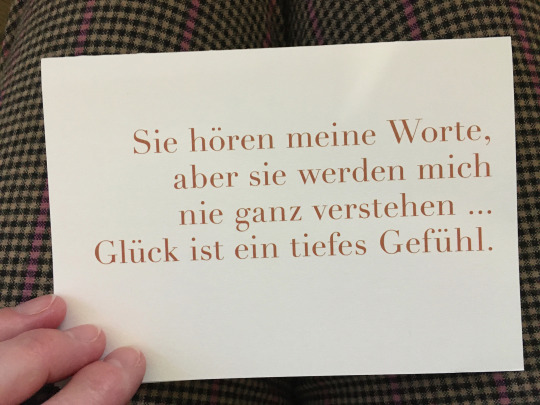

Foto: Frank Kleinbach, Stuttgart
8 Hat Dich das Thema der Erinnerung auch in anderen Werken beschäftigt?
Sie ist ein ständiger Begleiter – die Erinnerung, und sie betrifft fast alle meine Arbeiten. In frühen Werken arbeitete ich mit schwarzem Wachs. Dunkle Flächen, die ich mit dem Nichts gleichsetzte. Ihnen fehlt jegliche Erinnerung. Doch es gab auch dieses Überschreiben von einem Nichts durch das Ritzen von Zeichen. Es war nicht wichtig, ob sie lesbar waren, sondern, dass da etwas war, was man kennt. Für mich war Erinnerung immer mit Sprache assoziiert. Durch sie werde ich mit Menschen und Dingen vertraut.
9 Was ist Deine erste Erinnerung?
Ich erinnere einen Laufstall und wie mein rundes Beinchen über das Geländer schwingt. Ich ahnte, das wird abenteuerlich ...
10 Traust Du Deinen Erinnerungen? Warum?
Eine schwierige Frage. Ich denke, nein, ich traue meinen Erinnerungen nicht. Sie werden im Laufe der Jahre umgeschrieben, durch Erzählungen verändert, selektiert, durch Fotos auf ein bestimmtes Ereignis reduziert. Ich schreibe Tagebuch, schreibe das mir Wesentliche auf, um mich genau zu erinnern. Ich vertraue eher meinem Gefühl. Doch ich denke, wir brauchen auch das Erinnern vor der eigenen Erinnerung. Da liegt vieles im Dunklen, doch unsere Erinnerung ist wichtig für unser inneres Gleichgewicht, für das, was nicht vergessen werden darf.
11 Gibt es eine prägende Erinnerung an die Begegnung mit einem Kunstwerk in Deinem Leben?
Kunst im Alleingang erleben, konnte ich zum ersten Mal mit 17 Jahren. In den Uffizien sah ich mir viele Renaissance-Portraits an. Es war wie eine Zwiesprache. Doch besonders ergriffen war ich vom Gesicht der «Nacht» am Grab von Giuliano de Medici, geschaffen von Michelangelo.
12 Wo kann man Deine Kunst aktuell sonst noch sehen, und was sind Deine nächsten Projekte?
Aktuell zeige ich meine Wachsblumensträusse in der Gruppenausstellung MEMENTO im Museum für Sepulkralkultur in Kassel. Es gibt einen virtuellen 3D-Rundgang durch die Ausstellung, wobei man für das Navigieren etwas Übung braucht. Die nächste Ausstellung wird ab dem 1. Mai in der Galerie Vayhinger in Singen stattfinden, gemeinsam mit Daniel Bräg.

Karolin Bräg: Wachsblumensträusse
Ausstellungsansicht, Sepulkralmuseum Kassel 2021
13 Möchtest Du noch etwas mit unserem Publikum teilen?
Ich freue mich auf jede neue Begegnung – und das ganz real.
Aufgezeichnet am 4.3.2021
Karolin Bräg
wurde 1961 in Köln geboren. Heute lebt und arbeitet sie in München. Nach dem Abschluss ihres Studiums der Bildhauerei an der Akademie der Bildenden Künste in München hielt sie sich Mitte der 90er-Jahre zu Studienzwecken ein Jahr in Tokio, Japan, auf. 2005–2008 war sie Mitglied der Kommission für Kunst am Bau und Kunst im öffentlichen Raum, Quivid München und 2007–2010 künstlerische Assistentin am Lehrstuhl für Bildnerisches Gestalten an der Fakultät für Architektur der TU München. Seit Ende der 1980er-Jahre realisiert sie eigene künstlerische Projekte, oft auch auf Einladung, und beteiligt sich an Ausstellungen, mehrheitlich im deutschen Sprachraum. Ab und an entstehen Arbeiten gemeinsam mit Daniel Bräg.
Im Zentrum der künstlerischen Arbeit von Karolin Bräg steht das Gespräch. Im Gespräch schafft sie eine Atmosphäre des Vertrauens, die es ihrem Gegenüber möglich macht, auch Intimes und vermeintlich Unaussprechliches in Worte zu fassen. Je nach Thema und Anlass findet sie unterschiedliche Materialisierungen für die aus den Gesprächen entstehenden Werke. Im Falle einer früheren Zusammenarbeit mit unserer Direktorin Dorothee Messmer hat sie für die Arbeit «Mir gefällt’s recht gut da…» (Kunstmuseum des Kantons Thurgau, Kartause Ittingen, 2003) etwa die Form des Buches gewählt.
Mehr über die Künstlerin erfahren:
Website der Künstlerin
Publiziert am 24.3.2021
#Balkon#Blick in Ateliers#Atelierbesuch#Atelier#Karolin Bräg#München#Gespräch#Gesprächskunst#1OG#Ausstellungen#Memory#Erinnerung#Demenz#Fotografie
2 notes
·
View notes
Photo
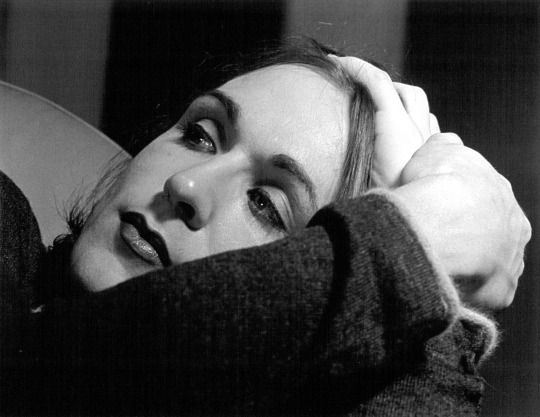
© Ruthie Singer-Decapite
CV
Terre Thaemlitz (1968) is an award winning multi-media producer, writer, public speaker, educator, audio remixer, DJ and owner of the Comatonse Recordings record label. Her work combines a critical look at identity politics - including gender, sexuality, class, linguistics, ethnicity and race - with an ongoing analysis of the socio-economics of commercial media production. He has released over 15 solo albums, as well as numerous 12-inch singles and video works. Her writings on music and culture have been published internationally in a number of books, academic journals and magazines. As a speaker and educator on issues of non-essentialist Transgenderism and Queerness, Thaemlitz has lectured and participated in panel discussions throughout Europe and Japan. As of January, 2001, he resides in Japan.
Terre was part in the last edition of Documenta in Athens and Kassel in 2017. For al full list of Terre Thaemlitz exhibitions and releases here
"Deproduction" AV world premiere at documenta 14 exhibition curated by Pierre Bal-Blanc and in coproduction with the Akademie der Künste der Welt, Athens Conservatoire, Athens Greece (July 9 2017); Tofufabrik, Kassel Germany (July 11 2017); Christuskirche, Köln Germany (July 13 2017).
"Lovebomb/愛の爆弾" video installation at documenta 14 exhibition curated by Pierre Bal-Blanc, Museum für Sepulkralkultur, Kassel Germany (June 10 through September 17 2017).
"Interstices" video installation at documenta 14 exhibition curated by Pierre Bal-Blanc, EMST― National Museum of Contemporary Art, Athens Greece (April 8 through July 16 2017).
0 notes
Text
20230316 JAPAN & BLUMEN
Blumen in Japan Blumen sind in vielen Kulturen ein wichtiger Bestandteil des Alltags.In Japan haben Blumen eine besondere Bedeutung und sind eng mit der Kultur und Tradition des Landes verbunden.Hier wird nun mal die Bedeutung von Blumen in Japan näher betrachtet und mit der europäischenbzw. deutschen Bedeutung verglichen.I. Die Bedeutung von Blumen in JapanA. Historische BedeutungB. Blumen als…
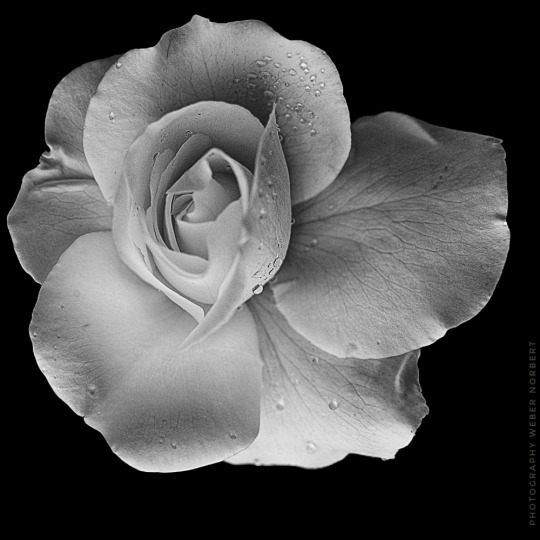
View On WordPress
#2023#© PHOTOGRAPHY BY NORBERT WEBER#BLUMEN#BUSHIDO#FLOWER#FLOWER-PHOTOGRAPHY#JAPAN#JAPAN AKADEMIE DER KÜNSTE#Japan history#JAPAN-ART#Japanese culture#Kampfkünste#SAMURAI
3 notes
·
View notes
Text
Christina Kubisch
Biography
Christina Kubisch was born in Bremen, Germany in the year 1948. She attended the Academy of Fine Arts in Stuttgart Germany where she studied painting with K.R.H. Sonderborg. She then goes on to studying music, that being flute piano and composition at the Academy of Music in Hamburg, Germany and t the Jazz Academy of Graz Austria following by attending the conservatory of Zurich and Fine Art in Switzerland. She finally moved to Milan in the mid seventies where she graduates from the Conservatory of Milan. Performances, concerts and works with video in the seventies, subsequently sound installations, sound sculptures and work with ultraviolet light. Her compositions are mostly electroacoustic, but she has written for ensembles as well. Since 2003 she works again as a performer and collaborates with various musicians and dancers. Kubisch won numerous awards, some of them being : the Award of the German Industrial Association (BDI) 1998, composition grant of the city of Berlin 2000, Carl Djerassi Honorary Fellowship, USA 2000, artist-in-residence IASPIS, Stockholm 2002, Honorary prize of the German Sound Art Prize 2008 and many more. Right fresh out of the Conservatory of Milan, in 1974, she had solo exibitions all over the world, in places like Japan, Australian, Europe. Her music has been released with various labels such as Cramps Records, Edition RZ, ampersand, semishigure, Die Schachtel, Olof Bright, AA Records.
Christina Kubisch has been a visiting professor in Maastricht, Paris and Berlin. She has been a professor for sound art at the Academy of Fine Arts, Saarbrücken, Germany, from 1994 to 2013. She is a member of the Akademie der Künste Berlin since 1997. Christina Kubisch lives in Hoppegarten near Berlin.
Analyses of Practice
As an artist she gained recognition in the mid-1970s with her early works including concerts, performances and multimedia installations; her works during that time are, for example, a live multimedia performance Two and Two (1977) and a minimalist composition Tempo Liquido (1979). At the turn of the 1980s she began to use electromagnetic induction in her sound installations: her work Il Respiro del Mare (1981) began her sound engineering career, as with it she developed a system for an electromagnetic sound induction. Since then she has been constantly refining her practice of staging the effects of wireless electromagnetic transmissions. Since 1986 she has been adding light as an artistic element to her work with sound. During that time, she created the pieces On Air (1984), Iter Magneticum (1986) and Night Flight (1987). In 1990, she began creating her first works with solar energy. In 1994, she created an installation Sechs Spiegel which is one of her most famous pieces: the piece uses the architectural proportions of the German building Ludgwigskirche to determine the rates of repetitions and pauses in vibrating drinking glasses. In 1996, she began The Clocktower Project in which she reactivated a clocktower that had long been out of commission: she created and recorded sounds for the project by ringing, striking, hammering and brushing the bells of the clock with different objects. In 2003, she began with her Electrical Walks projects: the walks are a sort of guided tour through a city, where participants are given special headphones, designed by Kubisch, and directed to parts of the city that have interesting soundscapes. Throughout her career, she has collaborated with various musicians – including Annea Lockwood, resulting in the CD The Secret Life of the Inaudible in 2018.
Technique
Christina is heavily known for her use of electromagnetic sound inductions and the designing of her headphones which were sensitive to the acoustic qualities of aboveground and underground electromagnetic fields, thus becoming amplified and audible.

The transmission of sound is achieved by built-in coils which respond to the electromagnetic waves in our environment. The palette of these noises, their timbre and volume vary from site to site and from country to country. They have one thing in common: they are ubiquitous, even where one would not expect them. Light systems, wireless communication systems, radar systems, anti-theft security devices, surveillance cameras, cell phones, computers, streetcar cables, antennae, navigation systems, automated teller machines, wireless internet, neon advertising, public transportation networks, etc. create electrical fields that are as if hidden under cloaks of invisibility, but of incredible presence.
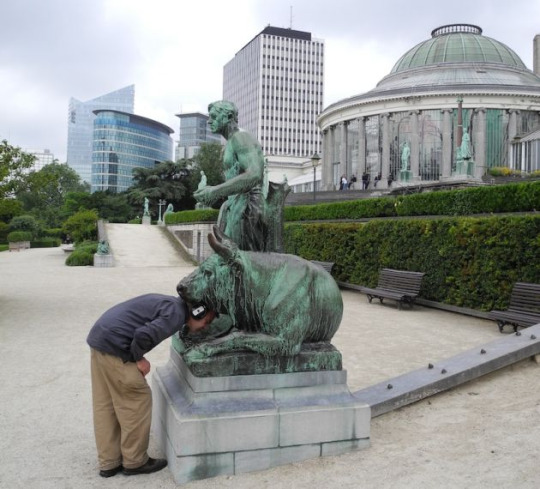
Electrical Walks
In 2003 she started her research on a new series of works in public space, which trace the electro-magnetic fields of urban environments in the form of city walks. The first Electrical Walk took place in Cologne in 2004. Many more, in numerous cities around the planet have taken place afterwards. The sounds that are detected by the headphones are much more musical than one could expect. There are complex layers of high and low frequencies, loops of rhythmic sequences, groups of tiny signals, long drones and many things which change constantly and are hard to describe. Some sounds are much alike all over the world. Others are specific for a city or country and cannot be found anywhere else.
Electrical Walks is an an invitation to a special kind of investigation of city centres (or elsewhere). With the magnetic headphone and a map of the environs, on which the possible routes and especially interesting electrical fields are marked, the visitor can set off on his own or in a group. The perception of everyday reality changes when one listens to the electromagnetic fields; what is accustomed appears in a different context. Nothing looks the way it sounds. And nothing sounds the way it looks.

Night Flights
One of the most highly regarded entries in Kubisch’s catalogue, out of print for some twenty years, but now unearthed for new generation of experimentally minded listeners to discover. The three extensive, finely detailed compositions tap into a different kind of electroacoustic idiom, far removed from the more familiar GRM-informed academic compositions that dominated the field during the mid-twentieth century. Night Flights can be regarded as a key text in contemporary sound art's evolution. The compositions are: Circles III, The Cats’ Dream and Night Flights.
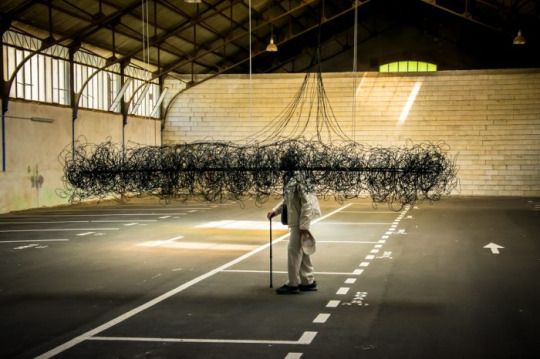
Cloud (2011/2017)
Sound sculpture made on site using a several hundred meters of red electrical cable. It is a multi-channel composition that visitors listen to by wearing customized magnetic headphones to explore the hidden acoustic world of sonic cable structures. Each channel has a different composition of electromagnetic waves, and listeners can mix them in their own way: these devices, developed by the artist, contain magnetic coils that receive magnetic fields circulating in cable loops and make them audible. As visitors move around the installation, around this chaotic electrical wiring, which is literally a cloud hanging in the gallery, they trigger the sounds of cables and mix them into an unlimited number of new combinations.

The Clocktower Project
solar panels, electronic sound system, and a computer with Kubisch’s unique program on its flash disc.
When Christina Kubisch first visited MASS MoCA in 1996, she was moved by the fact that the century-old factory clock had not kept time, nor had its bells rung. The classically trained musician and professor of experimental art, began playing the bells like musical instruments, ringing them with their clappers as well as hammering, brushing, and striking them with her hands and various tools. She recorded the bell tone database with a digital audio recorder. Kubisch then placed small solar sensors in a band encircling the tower just under the bell window. The sensors relay information about the intensity and location of the sun to a computer inside the tower. A unique software program, designed for this project by Berlin engineer Manfred Fox, interprets the solar information and combines Kubisch’s pre-recorded bell sounds in response to light conditions. Thus, a sunny summer morning generates loud, distinct, metallic tones, while a gray afternoon in winter brings about softer, somewhat melancholy sounds. At noon and 5pm, the computer plays a short pre-set concert, but at other times the brief compositions change with the quality of light and time of day. This use of unpredictable changes in the weather, coupled with an algorithmic function in the program that prevents the mini-compositions from repeating, marks the influence of the American composer and artist John Cage on Kubisch’s work.
The fading daylight, registered by the solar panels, causes The Clocktower Project to fall silent in the evenings. At the same time, the four faces of the clock begin to glow faintly and remain illuminated through the night. Kubisch coated the 4′-diameter clock faces with a phosphorescent paint and placed black lights behind the faces. The cool blue-white light quietly marks the transformation of the tower when the bell sounds have ceased.
0 notes
Text
A look into the works of some of the best designers of today

The best designers of today, regardless of where they come from have one thing in common: they fought long and hard to create a legacy in a world where quality design is more and more appreciated by a globalized and diverse society. Let’s have a little glace into some of the work and quality of many interior designers.
Ryan Korban
Ryan Korban started his career in interior design after graduating from The New School in New York. Without any formal training, he developed his unique aesthetic, characterized by a fusion of luxury, old-world romance, and urban cool.
Evoking several inspirations fluctuating from Monet paintings to Helmut Newton’s photography, he creates enchanting, astonishing spaces that surpass trend to redefine traditional design for a new generation.
His portfolio includes the homes of prominent figures in the worlds of fashion, film, and music. Specializing in retail design with an emphasis on luxury, Korban has completed some of the finest spaces in New York’s retail landscape. His work has been profiled in publications as Vogue, W, Harper’s Bazaar, Architectural Digest, the Wall Street Journal, and the New York Times.
You may also like: Studio Montanãna: the best of Valencian interior design
Kelly Hoppen
Kelly Hoppen‘s look has become one which is both widely recognized and used by many people around the world when developing the interior style for their own homes. Neutral palettes, beautiful textures and an East meets West aesthetic are all parts of her signature look. She always wanted people to feel a great sense of warmth in their home, wrapped in comfort and surrounded by gorgeous pieces, all of which help to enhance those feelings of calm and relaxation.
For many years she dreamed of designing her own collection of wonderful products for the home to maximize that feeling of serenity and happiness. This is the culmination of her years of experience and of knowing what works well. Her first collection of beautiful luxury products inspired all of us and gives us the confidence to create the home of our dreams. Hoppen wishes to encourage everyone to create their own aesthetic vision for interior design.
Rockwell Group
Rockwell Group is an interdisciplinary company that nurtures innovation in every project. Founded in 1984 by David Rockwell and commanded by partners Shawn Sullivan and Greg Keffer, they create extraordinary experiences and build environments in every single corner of the world.
Based in downtown New York with a satellite office in Madrid, they specialize in a wide collection of fields from luxury hospitality, cultural, and healthcare projects, to educational, product, and set design.
The merging of interactive technology, handmade pieces, custom works and furniture creates environments which perfectly incorporate technology, craftsmanship and design together.
Crafting a unique and individual narrative concept for each project is vital to Rockwell Group’s successful design approach. From the big picture to the smallest detail, the story expresses and leads the design.
Jonathan Adler
Jonathan Adler was born on August 11, 1966, in New Jersey. He is an American potter, designer, and author. Adler launched his first ceramic collection in 1993 at Barneys New York. Five years later he expanded into home furnishings, opening his first boutique in Soho, Manhattan. He now has 17 stores and runs a huge design business.
He strives to create luxury yet functional interiors that are carefully designed but don’t take themselves too seriously. His commitment to the finest craftsmanship and luxury is echoed in all he does. His projects go from furniture, lighting, home accessories, decorative objects to tabletop collections, bedding, bath accessories, candles, rugs, pillows, and many more. His extraordinary designs can be found in the best restaurants, hotels, and homes around the world.
You can also check out: Craftsmanship: the best of British Arts and Crafts
David Chipperfield
David Chipperfield founded David Chipperfield Architects in 1985. He was Professor of Architecture at the Staatliche Akademie der Bildenden Künste, Stuttgart from 1995 to 2001 and Norman R. Foster Visiting Professor of Architectural Design at Yale University in 2011. He taught and lectured worldwide at schools of architecture in Austria, Italy, Switzerland, the United Kingdom, and the United States. In 2012, David Chipperfield curated the 13th International Architecture Exhibition of the Venice Biennale.
He is also an honorary associated of both the American Institute of Architects and the Bund Deutscher Architekten, and a past winner of the Heinrich Tessenow Gold Medal, the Wolf Foundation Prize in the Arts, and the Grand DAI (Verband Deutscher Architekten- und Ingenieurvereine) Award for Building Culture. David Chipperfield was appointed Commander of the Order of the British Empire in 2004, appointed a Royal Designer for Industry in 2006, and elected to the Royal Academy in 2008. In 2009, he was awarded the Order of Merit of the Federal Republic of Germany and in 2010 he was knighted for services to architecture in the UK and Germany. In 2011 he received the RIBA Royal Gold Medal for Architecture, and in 2013, the Praemium Imperiale from the Japan Art Association, both given in recognition of a lifetime’s work.
David Collins Studio
David Collins Studio is an award-winning interior architecture atelier which creates creative and inspirational designs, residential and retail projects worldwide. It is a globally renowned brand and an expert in contemporary luxury design.
Established in 1985, The Studio collaborates with luxury brands and businesses which represent the best in their field, and with private clients that share its fascination with detail, craft and refinement. Based in London, The Studio organized projects across five continents, including The Wolseley, The Connaught Bar and Harrods Shoe Heaven in London, Gleneagles in Scotland, The Ritz-Carlton Residences at MahaNakhon in Bangkok, and The Delaire Graff Estate in South Africa.
Jean Nouvel
Jean Nouvel was born in Fumel, France in 1945. After joining the Ecole des Beaux-Arts in Bordeaux, Jean Nouvel ranked first in the entrance examination of the Ecole Nationale Supérieure des Beaux-Arts in Paris in 1966 and obtained his degree in 1972.
Assistant to the architect Claude Parent and inspired by urban designer and expert Paul Virilio, he started his first architecture practice in 1970. Soon afterwards, he became a founding member of the Mars 1976 movement whose purpose was to oppose corporatism in architecture. He also co-founded the Labor Union of French Architects in opposition to the existing national Board of Architects.
His strong beliefs and provocative opinions on contemporary architecture in the urban context together with his constant ability to insert a sense of originality into all the projects he accepts created his international reputation. Jean Nouvel’s work does not result from considerations of style or ideology, but from a quest to create a unique concept for a singular combination of people, place and time.
Ateliers Jean Nouvel (AJN)
Ateliers Jean Nouvel (AJN) is a world-renowned design company with a multicultural team of 140 people from more than twenty countries. AJN combines the fields of architecture, urban planning, interior design, landscape design, graphic design, and product design into a single integrated practice. Jean Nouvel’s award-winning designs and reputation attracted many prestigious collaborations. His portfolio of projects currently in progress includes museums, concert halls, conference centres, theatres, hotels, residential buildings, office buildings, commercial centres, and private residences.
Philippe Starck
“Subversive, ethical, ecological, political, humorous… this is how I see my duty as a designer”, explains Philippe Starck. His career is filled with 10,000 creations, global recognition and fruitful creativity, however, the main point of Philippe Starck’s success is his mission, a vision: that creation, whatever form it takes, must improve the lives of as many people as possible.
Starck passionately believes this poetic and political, rebellious and benevolent, pragmatic and subversive quest should be shared by everyone. He sums it up with the humour that made him stand out from the very beginning: “No one has to be a genius, but everyone has to participate”.
In his bright eyes, sharing his ethical and humanist vision of a more equal planet is a responsibility, if not a moral duty, that results in unconventional projects, bearing abundant surprises. It’s easy to guess his course of action: every object must be useful before being beautiful.
Starck’s prophetic concern with ecology, his deep understanding of contemporary transformations, his enthusiasm for imagining new lifestyles, his determination to change the world, his commitment to sustainability, his love of ideas, his concern with defending the intelligence of usefulness made him iconic.
From everyday products like furniture to revolutionary mega-yachts, intensely vibrant, stimulating and phantasmagorical hotels and the miraculous technologies of the electric car, he never stops pushing the limits of contemporary design. Starck is a true visionary who puts the art of innovation to the service of design and democratic ecology, being respectful to both human and nature’s heritage.
Tristan Auer
Tristan Auer’s style is eclectic, similar to the approach of the 20th century’s designers. He knows how to navigate between periods, from baroque to contemporary, and how to honour craftsmanship.
Karim Rashid
Karim Rashid is one of the most creative designers of his generation. Over 3000 designs in production, over 300 awards and working in over 40 countries show that Karim is a legend of design.
His award-winning designs include luxury goods for Christofle, Veuve Clicquot, and Alessi, democratic products for Umbra, Bobble, and 3M, furniture for Bonaldo and Vondom, lighting for Artemide and Fontana Arte, high tech products for Asus and Samsung, surface design for Marburg and Abet Laminati, brand identity for Citibank and Sony Ericsson and packaging for Method, Paris Baguette, Kenzo and Hugo Boss.
Karim’s work is featured in 20 permanent collections and he exhibits in several art galleries worldwide. Karim is a recurrent winner of the Red Dot award, Chicago Athenaeum Good Design award, I. D. Magazine Annual Design Review, IDSA Industrial Design Excellence award.
“For the longest time design only existed for the elite and for a small insular culture. I have worked hard for the last 20 years trying to make design a public subject”, Karim Rashid explains.
Patricia Urquiola
Patricia Urquiola (1961) was born in Oviedo (Spain) and currently lives in Milan. She studied architecture at the Polytechnic of Madrid where she graduated in 1989. From 1990 until 1992 she was an assistant professor in the courses given by Achille Castiglioni and Eugenio Bettinelli, both at the Polytechnic of Milan and E.N.S.C.I. in Paris. Between 1990 and 1996 she worked for the development office of new products of “De Padova” and signed with Vico Magistretti the products: “Flower”, “Loom sofa”, “Chaise” and “Chaise Longue”.
Between 1992 and 1996 Urquiola opened a studio with two friends, Renzio and Ramerino, working with architecture, interiors, restaurants, among others. In the next 4 years, she was the manager of the Lissoni Associati Group and in 2001 she opened her own studio in Milan, focused on product design and architecture. Patricia won many design awards, such as Antares-Flos, Artelano, Boffi, Cappellini, Cassina, Kartell. In addition to attending events, conferences and lectures she designed for B & B, Bosa, De Vecchi, Fasem, Kartell, Liv’it, MDF Italy, Molteni & C., Moroso and Tronconi.
Her products were selected for the 2001 Design Exhibition in Italy and for the Annual International Design Catalog of 1999 and 2001. In 2001 she was a jury of the 19th CDIM Design Competition and lectured at the Domus Academy. She currently conducts her professional career at her own craftsmanship studio in Milan in the fields of design, exhibitions, art direction and architecture.
India Mahdavi
India Mahdavi is the ruling queen of colour. “It’s the best way to bring sunshine into a space,” says the Paris-based interior designer. “Sunshine is happiness, and my work is about happiness.” Her admirers request for more. “They aren’t looking for mainstream,” Mahdavi explains. “They tend to be people who are looking ahead.” Indeed, the unique creativity of her rooms is not for the faint of heart.
The architect and designer India Mahdavi was born in an Anglo-Persian family and spent her childhood between Massachusetts, New York, Heidelberg, South France and Paris. Her style reflects her personality: multilingual, multicultural and polychrome.
She graduated in architecture (DPLG – Paris), industrial design (Copper Union, New York), graphic design (School of Visual Arts, New York) and also specialized in furniture design (Parson’s NYC). Her studio, founded in 1999, is internationally celebrated for signing several designs, ranging from architecture to interior, furniture and product design.
India Mahdavi designed famous hotels and restaurants such as Condesa DF in Mexico, on Rivington in New York, Monte Carlo Beach in Monaco, Coburg bar and Hélène Darroze restaurant in London’s Connaught, Claridge’s suites in London, Hôtel Thoumieux in Paris, Hôtel du Cloître in Arles, Café Français in Paris (Place de la Bastille) in collaboration with M / M (Paris), L’Apogée Courchevel co-signed with Joseph Dirand and The Gallery at Sketch restaurant from London. The interiors signed by her are elegant, fluid, and always characterized by a strong connection with the essence of the place.
Dimore Studio
Emiliano Salci and Britt Moran invested in the fields of Design, Art and Fashion, and founded Dimore Studio in 2003. Since that moment, they designed and carried out every project with their own unique signature style: pieces created by historical design master artisans merged with domestic materials and other modified objects to forge a singular atmosphere. A timeless visual and emotional pathway.
Their research is focused on details which make every new creation exquisite and sophisticated. Their language is inspired by a collection of emotional alchemies made of unexpected choices, appreciation of prints, lights, lacquers and oxidations. An uncensored aesthetic where each item has its own power and expressive “raison d’être. Dimore Studio interprets memories and creates dreams, crossing the boundaries between art and design, fashion and architecture.
Marcel Wanders
Marcel Wanders is a talented product and interior design studio credited with more than 1.900 iconic projects. Under the creative leadership of the artist and craftsman Marcel Wanders, who is supported by Gabriele Chiave since 2014, the multi-disciplinary team of 40 breathes creativity across several fields.
Marcel Wanders works with notorious luxury brands such as Alessi, Baccarat, Bisazza, Christofle, Kosé Corporation, Flos, KLM, Hyatt Hotels Corporation, Louis Vuitton, Morgans Hotel Group, Puma, Swarovski. Today, many of Marcel Wanders’ designs are celebrated in some of the most renowned museums in the world, including the Centre Pompidou (FR), MoMA (US), and Stedelijk Museum Amsterdam (NL).
Marcel Wanders is reshaping the design industry and encouraging a more romantic and humanistic design thinking. Respecting the past and the diversity of cultures, he develops a contemporary language that is personal yet a catalyst for the post-post-modernist era he calls the “Contemporary Renaissance of Humanism”.
Tadao Ando
Tadao Ando was born on 13 September 1941 and he is a Japanese self-taught architect whose approach to architecture and landscape was categorized by architectural historian Francesco Dal Co as “critical regionalism”. He is the winner of the 1995 Pritzker Prize.
Ando was raised in Japan where religion and lifestyle deeply influenced his architecture and design vision. Ando’s architectural style is said to create a “haiku” effect, emphasizing nothingness and empty space to represent the beauty of simplicity.
He loves designing complex yet beautiful interiors while maintaining the appearance of simplicity. Tadao Hando also treasures his Japanese culture and language, keeping them in mind while he travels around Europe for research. As an architect, he believes that architecture can change society, that “to change the dwelling is to change the city and to reform society”.
Campana Brothers
The Campana Brothers, Fernando (b. 1961) and Humberto (b. 1953), are, undoubtfully, prodigies of contemporary design. They were born in Brotas and started working together in 1983 in São Paulo, Brazil, where they still live and work at Studio Campana.
Despite being two of the best designers in the world, their lives weren’t always in that path. Humberto studied to be a lawyer but decided that his true passion was sculpting. Fernando decided to study architecture but soon wanted to work with his brother and create innovative and groundbreaking furniture design.
The world started to notice their true talent in 1991 when they developed the “Favela Chair”, made from scraps found in a São Paulo shanty town. From there, they brought to life “Vermelha Chair”, “Cone Chair” and “Estrela Lamp”. The media started to cover them in 1998, when they became the first Brazilian artists to showcase their work at the renowned Museum of Modern Art (MoMA) in New York, along with the German lightning design Ingo Maurer, in an exhibition called “Project 66”, curated by Paola Antonelli.
In that year they also started a partnership with the Italian brand Edra. Every year, the brothers launch new works of art and concepts in collaboration with international brands such as Alessi, Artecnica, Bernardaud, Baccarat, Corsi Design, Consentino, Nodus, Magis, Moleskine, Skitch, Plus Design, Venini, and Trousseau, among many others.
In 2002, Studio Campana began to craft its own line of exclusive, limited edition and unique handmade designs. These special editions are represented by the best international art galleries including Friedman Benda in New York, Galleria O in Rome, Carpenters Workshop Gallery in London, Firma Casa in Sao Paulo, David Gill in London and Kreo in Paris, among others.
The outstanding “Vermelha Chair” is still their best seller. At the Design Museum in London, the history of their work was told and nowadays their art pieces are frequently exhibited at acclaimed museums all over the world.
★
SUBSCRIBE HERE TO OUR NEWSLETTER
and get the latest news about the works of some of the best designers of today as well as some other inspirational topics in the world on furniture and interior design! Feel free to follow us on social media for more inspiration: Instagram | Pinterest
★

from Sebastian Kurz Blog https://www.designbuildideas.eu/look-works-best-designers-today/
0 notes
Text
Stefan Diez
Stefan Diez. Diseñador de mobiliario, productos y exposiciones.
Stefan Diez (1971, Freising, Baviera, Alemania) es un diseñador alemán que estudió y se licenció en Diseño Industrial en la Academia Estatal de Arte y Diseño de Stuttgart (Staatliche Akademie der Bildenden Künste).
Los inicios de Stefan Diez en el mundo del diseño de muebles comenzaron en 1991, cuando durante tres años trabajó como ebanista.
Después de haber pasado un año trabajando en Mumbai y Poona (India), Stefan Diez regresó a Alemania en 1996 para asistir a la Universidad.
Antes de fundar su Estudio, Stefan Diez trabajó como asistente para los diseñadores Richard Sapper y luego para Konstantin Grcic.
Stefan Diez fundó en enero de 2003 su propio estudio, Diez Office (Munich), donde desarrolla muebles, vajillas, accesorios y diseños de exposiciones.
Stefan Diez desarrolla productos innovadores y creativos, así como un trabajo intensivo de investigación con materiales. Sus productos se puede decir que son diseños minimalistas con un sentido del humor sin pretensiones.
Diez trabaja intensamente con materiales y con la tecnología, siempre buscando conocer sus limitaciones. Junto con su oficina desarrollan productos que son sencillos pero precisos y sobre todo están destinados a satisfacer las necesidades humanas.
Diez Office ha trabajado en diversos campos del diseño que van desde muebles y vajilla, hasta diseño industrial o el diseño de exposiciones, para empresas como: Authentics; Bree; e15; Established & Sons; Gandia Blasco; Moroso; Rosenthal; Thonet; Wilkhahn; Elmar Flötotto; Schönbuch; Merten; mobiliario de oficina para HAY, y otros.
En 2008 fue director de arte de Authentics, junto con Mirko Borsche y Christian Gärtner, y desde 2007 es profesor de Diseño Industrial en la HFG Karlsruhe University of Arts and Design.
En 2013 presentó la serie de asientos, progresiva y engañosamente simple, “This”, “That” y “Other” para e15; que ilustra la clave de la filosofía que ésta compañía expone y presenta en todo lo que hace : elementos esenciales para construir un producto.
Stefan Diez aplica el mismo material (madera contrachapada) que para la serie icónica “Houdini” (2009), también para e15, y con una gama de colores desarrollada por Farah Ebrahimi.
Proporcionando el máximo confort, las formas redondeadas de esta serie de asientos dan paso a un espíritu moderno y a detalles racionales, y representa una oferta muy económica al simplificar la construcción.
En la Conferencia de Creatividad Design Indaba de Ciudad del Cabo (del 1 al 3 de marzo de 2017) Stefan Diez mostró la colección “Soba“, que diseñó en 2015.
Ésta colección cuenta con un banco de bambú y un par de caballetes que pueden soportar una mesa. Cada tronco se ha dejado en su estado natural que cambia de color con el tiempo, y los muebles se ensamblan enhebrando las cuerdas a través de las cañas y atando piezas individuales juntas, y no requiere herramientas ni fijaciones.
El diseñador industrial con sede en Munich creó la serie en asociación con la iniciativa sin ánimo de lucro Japan Creative, que enfatiza el uso de la artesanía tradicional japonesa para piezas contemporáneas y que cada año invita a tres diseñadores de Europa y Estados Unidos a participar en talleres sobre materiales y/o formas de trabajo tradicionales.
Stefan Diez -que también ha creado mobiliario de oficina experimental para pequeños lugares de trabajo- tuvo la oportunidad de colaborar con una fábrica de bambú, un material cuya planta crece rápidamente y se puede cultivar sin depender de pesticidas o fertilizantes, utilizada tanto para edificios como para proyectos de diseño más pequeños, que está viendo cada vez más aumentar su interés.
Muchos de sus productos han recibido premios internacionales de diseño, entre ellos el Designpreis der Bundesrepublik Deutschland (DBD), el iF Gold Design Award, y el Red Dot Best of the Best Award.
Stefan Diez (pág. web).
Stefan Diez, y la colección de sillas “This”, “That” y “Other”, presentada en 2013 en el Salone Internazionale del Mobile de Milán : “This”, una silla de comedor; “That”, una silla baja, y “Other”, un taburete alto, para la la marca alemana de muebles e15.
AllABCDEFGHIJKLMNOPQRSTUVWXYZ
A
Achille Castiglioni
Adolf Loos
Alessandro Mendini
Alfredo Häberli
Alvar Aalto
Andrea Branzi
Andrée Putman
Andreu Carulla
Andy Martin
Antonio Citterio
Arend Groosman
Arik Levy
Arne Jacobsen
Autoban
B
BarberOsgerby
Benjamin Graindorge
Benjamin Hubert
Bertjan Pot
Boca do Lobo
C
Carlo Alessi
Carlo Mollino
Charles Rennie Mackintosh
Charles y Ray Eames
Claudio Colucci
D
David Adjaye
Dieter Rams
DimoreStudio
Doriana y Massimiliano Fuksas
Doshi Levien
E
Edward van Vliet
Eero Saarinen
Eileen Gray
Elena Manferdini
Enzo Mari
Ettore Sottsass
F
Fabio Novembre
Fernando Mastrangelo
Filippo Mambretti
Finn Juhl
Formafantasma
Francesco Rota
Frank Gehry
Frank Lloyd Wright
Fredrikson Stallard
G
Gabriella Crespi
Gae Aulenti
Gaetano Pesce
George Nelson
George Sowden
Gerrit Rietveld
Gio Ponti
Goula Figuera
H
Hans J. Wegner
Héctor Serrano
Hella Jongerius
Hermanos Campana
Hervé Van der Straeten
I
India Mahdavi
Inga Sempé
J
Jaime Hayón
Jasper Morrison
Jean Prouvé
Jean-Marie Massaud
Joaquim Tenreiro
Joe Colombo
Johan Lindstén
Jonathan Adler
Joost Van Bleiswijk
Jörg Schellmann
Josef Hoffmann
Jurgen Bey
K
Karim Rashid
Kelly Wearstler
Kiki Van Eijk
Konstantin Grcic
L
Le Corbusier
Lex Pott
Lievore Altherr
Lucas Muñoz Muñoz
Ludovica y Roberto Palomba
M
Maarten Baas
Maarten Van Severen
Marc Newson
Marcel Breuer
Marcel Wanders
Marianne Brandt
Matali Crasset
Matteo Thun
Mattia Bonetti
Max Lamb
Michael Anastassiades.
Michele de Lucchi
Mies van Der Rohe
Miguel Milá
N
Nadadora
Naoto Fukasawa
Nendo
Nigel Coates
Nika Zupanc
O
Olivier Mourgue
Ora Ïto
OS and OOS
P
Paola Navone
Paolo Lomazzi
Patricia Urquiola
Patrick Naggar
Patrick Norguet
Philippe Starck
Piero Fornasetti
Pierre Paulin
Piet Hein Eek
Q
Quentin de Coster
R
Richard Hutten
Richard Sapper
Rick Owens
Rodolfo Dordoni
Ron Arad
Ron Gilad
Ronan & Erwan Bouroullec
Ross Lovegrove
S
Sacha Lakic
Scholten & Baijings
Seung-Yong Song
Shiro Kuramata
Simone Simonelli
Snarkitecture
Stefan Diez
Studio Job
Studio Kaksikko
T
Tapio Wirkkala
Tejo Remy
Thomas Sandell
Tokujin Yoshioka
Tom Dixon
Toni Grilo
U
Ueli y Susi Berger
UUfie
V
Verner Panton
Vico Magistretti
Vincent Van Duysen
Vincenzo de Cotiis
Vladimir Kagan
Von Pelt
W
William Plunkett
William Sawaya
X
Xavier Lust
Xavier Mañosa
Y
Yrjo Kukkapuro
Yves Béhar
Z
Zaha Hadid
Zanuso
from http://decorador.online/disenadores-destacados/stefan-diez/
0 notes
Text
Der gebürtige Zwickauer erhält den fünften Max-Pechstein-Ehrenpreis. In der Preisträgerausstellung stellt der in Leipzig lebende und arbeitende Künstler vom 11. November 2017 bis 18. Februar 2018 neue Arbeiten unter dem Titel „TIME“ vor. Neben den farbintensiven Gemälden Hartwig Ebersbachs werden originale Grafiken von Max Pechstein zu sehen sein.
#gallery-0-5 { margin: auto; } #gallery-0-5 .gallery-item { float: left; margin-top: 10px; text-align: center; width: 33%; } #gallery-0-5 img { border: 2px solid #cfcfcf; } #gallery-0-5 .gallery-caption { margin-left: 0; } /* see gallery_shortcode() in wp-includes/media.php */
Dem Künstler Hartwig Ebersbach wird am 10. November 2017, um 18 Uhr, durch die Zwickauer Oberbürgermeisterin Dr. Pia Findeiß der Max-Pechstein-Ehrenpreis der Stadt Zwickau verliehen. Der Max-Pechstein-Preis wurde erstmals 1947 im Beisein des Mitbegründers der „Brücke“, Max Pechstein, vergeben. Die Verleihung erfolgt im Zweijahresrhythmus ‑ zweimal hintereinander als Förderpreis für junge Künstler oder Künstlergruppen. Seit 1993 wird die Auszeichnung alle sechs Jahre als Ehrenpreis für das Gesamtwerk eines profilierten Künstlers der Gegenwart ausgelobt. Der Preisträger für den Max-Pechstein-Ehrenpreis wird durch den Kunstverein Zwickau e.V. vorgeschlagen. Bisher erhielten der Wiener Künstler Alfred Hrdlicka (1993), der Publizist und Sammler Lothar-Günther Buchheim (1999), der Leipziger Maler Arno Rink (2005) und der politische Plakatkünstler Klaus Staeck (2012) die Auszeichnung.
Die wilde, expressive Malerei wurde schon früh zu Ebersbachs Markenzeichen. Mittlerweile gehört sein Werk zu den wichtigsten und eigenständigsten Positionen innerhalb der deutschen Malerei. Es hat bereits in der ehemaligen DDR mit seiner systemkritischen Haltung überregionale Resonanz erfahren. Als einer der bedeutendsten Maler seiner Generation erhielt Ebersbach schon damals internationale Anerkennung. Wichtige Einzelausstellungen oder Beteiligungen fanden in China und den USA, in Frankreich, Belgien und Japan sowie in der Schweiz statt ‑ und das auch schon vor 1989. Zudem sind die Werke des Künstlers weltweit in wichtigen privaten wie öffentlichen Sammlungen vertreten (u. a. Ludwig Museum Budapest, Kunsthalle Bremen, Kunstmuseen in St. Petersburg, Peking, Wien, Berlin, Dresden und Leipzig).
Zur Preisträgerausstellung
„Time, Gentlemen, please! “ ‑ so läutet der Wirt im englischen Pub die letzte Runde ein. Diesen sarkastischen Titel gab der 85-jährige Oskar Kokoschka dem letzten seiner späten Selbstbildnisse. In dem 1971/72 entstandenen Gemälde, das zu Ebersbachs Lieblingsbildern zählt, öffnet der Todeswächter dem Künstler die Tür zum Jenseits und macht sich an seinem Herzen zu schaffen.
Auch Ebersbach beschäftigt sich seit einiger Zeit mit der eigenen Endlichkeit, und dies mit höchster Intensität. So eröffnete der Künstler mit einer Neuinterpretation von Kokoschkas Selbstbildnis 2015 eine Serie mit dem Titel „TIME“, gleichsam namensgebend wie inhaltlich richtungsweisend für die Zwickauer Ausstellung. Angriffslustig kehrt er das Geschehen um: „TIME“ in Spiegelschrift! Hier steht Ebersbachs Alter Ego, der Kaspar, an der Schwelle zur „Zeitlosigkeit“. Wollte Kokoschka mit seinem Werk den „bösen Blick“ abwehren, malt sich Ebersbach die andere Seite einfach hell. In dieser Serie erkennen wir Ebersbachs Vertraute in neuen Konstellationen: Kasperköpfe, Engel und Teufel bestimmen nach wie vor sein Figurentheater und scheinen den Tod in ihr Programm aufgenommen zu haben.
Die wilde, expressive Malerei, die sich bisweilen zu pastosen und energischen Materialschlachten steigern kann, wurde schon früh zu Ebersbachs Markenzeichen. Überregional und international bekannt wurde er vor allem durch seine Kaspar-Bilder, die von unbändiger Fabulierlust und Experimentierfreude geprägt sind. Mittlerweile gehört das Werk von Hartwig Ebersbach, der 1940 in Zwickau geboren wurde und Anfang der 1960-er Jahre bei Bernhard Heisig an der Leipziger Hochschule für Grafik und Buchkunst studierte, zu den wichtigsten und eigenständigsten Positionen innerhalb der deutschen Malerei. Ebersbach beschäftigt sich mit Mythen und Sagen und reagiert künstlerisch auf seine Erlebnisse wie Träume. Seine jüngsten Arbeiten thematisieren neben der eigenen Vergänglichkeit auch den globalen Umbruch und die Neuordnung der Gesellschaft. In einer krisengebeutelten Welt, in der das Gefühl der Sicherheit verlorengegangen zu sein scheint, rückt dabei eine frei zu interpretierende „Gottsuche“ ins Bild. Auch der ebenfalls in Zwickau geborenen Expressionist Max Pechstein (1881-1955) kennt diese Welt. Und so steht die nach der Erfahrung des Ersten Weltkrieges geschaffene Holzschnitt-Folge „Das Vater Unser“ von Pechstein Ebersbachs „Kaspar Kalligramm Gekreuzigter“ oder „Himmelfahrt“ nicht nur innerhalb der Sonderausstellung gegenüber, sondern begegnen sich nach zahlreichen gemeinsamen biografischen Berührungspunkten auch „H.E.“ und „M.P.“ in einer von Ebersbach geschaffenen Serie auf der Leinwand. It’s about „TIME“.
Biografie Hartwig Ebersbach
1940 in Zwickau geboren, aufgewachsen ab 1945 auf einem Bauernhof in Lichtentanne
1958-59 Besuch der Mal- und Zeichenschule Zwickau, Unterricht bei Carl Michel und Tatjana Lietz
1959-64 Studium in Leipzig an der Hochschule für Grafik und Buchkunst bei Bernhard Heisig
1964-79 als freier Messe- und Ausstellungsgestalter tätig
1973 erste Einzelausstellung in der Galerie Kunst der Zeit, Leipzig (gemeinsam mit seinem Bruder Wolfram Ebersbach)
1978 Zusammenarbeit mit dem Komponisten Friedrich Schenker am szenischen Kammerspiel MISSA NIGRA (1979 in Leipzig uraufgeführt, weitere Aufführungen u.a. in Italien, Frankreich, Schweiz)
1979 erste Westeuropa-Reise zur Kunstmesse art Basel, Begegnung mit ihm wichtigen Kunstäußerungen (z.B. Walter Stöhrer)
1979-83 Lehrtätigkeit für experimentelle Kunst an der Hochschule für Grafik und Buchkunst Leipzig
1981-83 Mitglied der experimentellen Gruppe 37,2, die nach neuen strukturellen Möglichkeiten der Produktion und Rezeption von Kunst suchte, um die Funktion von Kunst in der Gesellschaft neu zu definieren
1982 erste retrospektive Personalausstellung im Staatlichen Lindenau-Museum Altenburg
1983 Herzinfarkt aufgrund exzessiver Lebensführung, stärker werdender politischer Zwänge, Reisebeschränkungen, Ausstellungsverboten und -schließungen, Neudefinition der künstlerischen Existenz
1985 Kunstpreis der Künstler, Düsseldorf (Entgegennahme 1986)
1988 erste USA-Reise (Personalausstellung in New York)
1989 USA-Reise nach Chicago (Teilnahme an Kunstmesse), Japan-Reise (Ausstellungstournee „Zeitzeichen“)
seit 1992 zahlreiche Reisen auf alle Kontinente
1992 Gründungsmitglied der Freien Akademie der Künste zu Leipzig, Rede vor der Enquete-Kommission des Deutschen Bundestages
seit 1996 Mitglied der Akademie der Künste Berlin
Mitglied der Sächsischen Akademie der Künste Dresden
2005 China-Reise (Künstlersymposium, Ernennung zum Künstler des Hauses Wuyishan)
2006 Jerg-Ratgeb-Preis, Reutlingen
seit 2012 Entdeckung der Landschaft Südtirol als künstlerisches Thema
seit 2014 Beendigung der Fußmalerei, Rückkehr zu traditioneller Malerei mit der Erfahrung der stetigen Brüche
2015 Retrospektive zum 75. Geburtstag in den KUNSTSAMMLUNGEN ZWICKAU Max-Pechstein-Museum
Hartwig Ebersbach lebt und arbeitet in Leipzig.
Quelle: Stadt Zwickau
Helfen Sie bitte mit, dass es Hit-TV.eu auch morgen noch gibt. Mit 12 € pro Jahr (1 € pro Monat) sichern Sie die Existenz von unabhängigem Journalismus. (weitere Infos unterm Menüpunkt Spenden) Spenden bitte per Paypal: [email protected] oder per Bank an: Hit-TV.eu IBAN: DE36 8707 0024 0047 7901 00 BIC: DEUTDEDBCHE (Deutsche Bank) Buchungstext “Spende”
Hartwig Ebersbach erhält Max-Pechstein-Ehrenpreis Der gebürtige Zwickauer erhält den fünften Max-Pechstein-Ehrenpreis. In der Preisträgerausstellung stellt der in Leipzig lebende und arbeitende Künstler vom 11.
0 notes
Video
vimeo
MISS READ 2016 video documentation
Video commissioned by MISS READ and produced by PRESSURE.
MISS READ: The Berlin Art Book Fair 2016 took place on June 10 to 12 at Akademie der Künste Berlin and brought together a wide selection of some 200 publishers, art periodicals and artists/authors. Founded in 2009, MISS READ is Europe's Art Book Festival, dedicated to community-building and creating a public meeting place for discourse around artists´ books, conceptual publications and publishing as practice. Admission is free.
Featuring 200+ international participants with 2016´s special focus on Spanish-speaking countries, MISS READ was accompanied by series of lectures, discussions, book launches and workshops, exploring the boundaries of contemporary publishing and the possibilities of the book.
On Friday, June 10, MISS READ STAGE focused on Publishing as Artistic Practice with panels, book presentations and lectures by Annette Gilbert, Eleanor Vonne Brown, Eva Weinmayr, Hannes Bajohr, Paul Soullelis and the Mexican collective Rrréplica meeting/encounter/clash of rebellious/disobedient/unruly publishers/editors/printers and duplicators.
Friday's public programmes schedule is available here.
On Saturday, June 11, the fourth Conceptual Poetics Day explored the imaginary border between visual art and literature. It featured readings, talks, performances and books by Eugen Gomringer, James Sherry, Matvei Yankelevich, Cordula Daus, Paul Soulellis, Franz Thalmair, Lois Bartel, Stefan Riebel, Ignacio Uriarte, Hank Schmidt in der Beek, Annette Gilbert, Thomas Thiel, Arno Auer, Cia Rinne, and many more.
The detailed program of the Conceptual Poetics Day 2016 is available here.
On Sunday, June 12, MISS READ STAGE presented lectures, booklaunches and a symposion on How to Collect Artists Books, organised in collaboration with Zentrum für Künstlerpublikationen Weserburg and featuring presentations by Anne Thurmann-Jajes, Tony White, Eva Linhart and Beatrice Hernad, among others.
Sunday´s public programmes schedule is available here.
To sustain our activities, we occasionally publish fundraising editions.
More information about our editions with John Stezaker, Cia Rinne, Haris Epaminonda and Eugen Gomringer is available here.
Participants:
88books (Vancouver) / A BALZAC A RODN (Paris) / ABC [Artists’ Books Cooperative] (New York and elsewhere) / adocs (Hamburg) / Afterall (London) / Akademie der Künste (Berlin) / AKV (Berlin) / Alt Går Bra (Bergen, Norway) / Anagram Books (London/Berlin) / AND Publishing (London) / Animal Press (Brussels) / Apparent Extent (Cologne) / Archive Books (Berlin) / Archive Artist Publications (Munich) / Åse Eg Jørgensen (Copenhagen) / ATLAS Projectos (Lisbon/Berlin) / August Verlag (Berlin) / Bartleby & Co. (Brussels) / Baeckerei (Berlin) / BLEK (Leipzig, Germany) / Boabooks (Geneva) / BOM DIA BOA TARDE BOA NOITE (Berlin) / BOMB Magazine (New York) / Book Works (London) / Brad Downey (Berlin)/ Brinkmann & Bose (Berlin) / Broken Dimanche Press (Berlin) / Bücher & Hefte (Berlin) / Bücherbogen (Berlin) / bywater bros (Port Colborne, Canada) / Camera Austria (Graz, Austria) / Cabinet Magazine (Brooklyn) / Cia Rinne (Berlin) / Colour Code (Toronto) / Dennis McGrath (Los Angeles) / Dirty Flower Press (Berlin) / Doppell (Berlin) / drittel books (Berlin) / Edit e.V. (Leipzig) / Edition Fink (Zurich) / edition.nord (Niigata, Japan) / Éditions Incertain Sens / Cabinet du livre d'artiste (Rennes, France) / Edizione Multicolore (Leipzig) / ENDLESS EDITIONS (New York) / Eugen Gomringer (Rehau, Germany) / Fantôme Verlag (Berlin) / FH Dortmund (Dortmund, Germany) / Flaneur Magazine (Berlin) / Folkwang UdK (Essen, Germany) / Fotograf (Prague) / Frans Masereel Centrum (Kasterlee, Belgium) / FUKT (Berlin) / g*press (Amsterdam) / GAGARIN(Antwerp) / Galavant Magazine (Singapore) / Galerie Neu (Berlin) / Girls Like Us (Amsterdam) / Gloria Glitzer (Berlin) / Grafter's Quarterly (Bergen, Norway) / Grazer Kunstverein (Graz, Austria) / GRRRR (Zurich) / Hamburger Eyes (Los Angeles) / Hank Schmidt in der Beek (Berlin) / Hard Mag (London) / Haris Epaminonda (Berlin) / Impractical Labor (Bridgeport, USA) / indekeuken (Brussels) / JB. Institute (Berlin) / Journal of Aesthetics & Protest (Los Angeles) / Kerber Verlag (Bielefeld) / KHB Weißensee (Berlin) / Knuckles & Notch (Singapore) / Knust/Extrapool (Nijmegen, the Netherlands) / Kontaktcenter (Hamburg) / KudlaWerkstatt (Prague) / Kultur & Gespenster (Hamburg) / Künstlerhaus Bethanien (Berlin) / Kunstverein Milano (Milan) / Kunstverein Publishing (Amsterdam) / kuš! (Riga, Latvia) / KUTA HOUSE* (Warsaw) / Library of the Printed Web (New York) / Look Back and Laugh Books (Ljubljana, Slovenia) / lorem ipsum (Rennes, France) / Lubok Verlag (Leipzig) / MATERIA (Rome) / MER Paper Kunsthalle (Ghent, Belgium) / MGLC International Center of Graphic Arts (Ljubljana, Slovenia) / Miami books (Geneva) / Michael Baers (Berlin) / Michalis Pichler (Berlin) / MIT Press (Cambridge, USA) / Montez Press (Hamburg) / mzin (Leipzig) / nbk (Berlin) / NoRoutineBooks (Vilnius, Lithuania) / Nos:books (Taipei) / Occulto (Berlin) / Onomatopee (Eindhoven, the Netherlands) / ottoGraphic (Marshfield, UK) / Palefroi (Berlin) / par(ent)esis (Florianopolis, Brazil) / Paul Soulellis (New York) / Pegacorn Press (New York) / Peleja (Florianopolis, Brazil) / PogoBooks (Berlin) / possible books (Berlin) / Poster Tribune (Carouge, Switzerland) / PrintRoom (Rotterdam) / Ptohograhpies (Berlin) / Publication Studio (Rotterdam) / Ethan Rafal (San Francisco) / Raum der Publikation (Kiel) / Re:Surgo! (Berlin) / Red Sphinx (Berlin/London) / Red76 (Portland, USA) / Roma Publications (Amsterdam) / Rondade (Tokyo) / Salon du Salon (Marseille) / Salon für Kunstbuch (Vienna) / Sarah and Schooling (Singapore) / Schlebrügge.Editor/Fama & Fortune Bulletin (Vienna) / Scriptings/Achim Lengerer (Berlin) / Sergej Vutuc (Heilbronn, Germany) / shashasha collective (Tokyo/Paris/Leipzig) / SKULPI (Berlin) / slow editons (Yokohama, Japan) / Small Tune Press (Hong Kong) / Space Poetry (Copenhagen) / Spector Books (Leipzig) / springerin (Vienna) / Städelschule (Frankfurt) / Starship (Berlin) / Sternberg Press (Berlin) / Zentrum für Künstlerpublikationen Weseburg (Bremen, Germany) / supersupersupersuper (Amsterdam) / Susanne Bürner (Berlin) / TBooks (Cologne) / textem (Hamburg) / TFGC Publishing (Düsseldorf) / TLTRPreß (Berlin) / the blue notebook (Bristol, UK) / the everyday press (Paris) / The Newww (Venice) / The Name Books (Chur, Switzerland) / Elgarafi .The Postershop (Berlin) / Tiny Masters (Leipzig) / Tiny Splendor (Berkeley/Los Angeles) / Toupée (Berlin) / Triangle Books (Brussels) / Ugly Duckling Presse (Brooklyn) / Unity Press (Oakland) / Verlag der Buchhandlung Walther Koenig (Cologne) / Verlag Silke Schreiber (Munich) / Verlak (Weimar, Germany) / Verlag für moderne Kunst (Vienna) / von100 (Berlin) / Werkplaats Typografie (Arnhem, the Netherlands) / Westphalie (Vienna) / White Fungus (Taiwan) / wicker industries GmbH & Co. KG (Berlin) / X Marks the Bökship (London) / zero sharp (Berlin) / zirkumflex (Berlin) / ztscrpt (Berlin/Vienna) and many more...
The detailed exhibitor list is available here
Hispanic Focus:
Adolfo Press (Barcelona) / Autoedita con Alegría (Madrid) / Back Bone Books (Berlin/Mexico City) / Bandiz Studio (Madrid) / Calipso Press (Cali, Columbia) / Casa del Hijo del Ahuizote (Mexico City) / Clandestine (Barcelona/Mexico City) / Do the Print (Barcelona) / Ediciones Anómalas (Barcelona) / FIBRA Casa Editora (Buenos Aires) / Gato Negro (Mexico City) / Las Otras (Santiago de Chile) / Libros Mutantes (Madrid) / Humobooks (Buenos Aires) / KINK EDICIONES (Barcelona) / Kitschic (Barcelona/Bogotá) / Morena Publications (Barcelona) / RAUM Editions (Salamanca, Spain) / Pupa Press (Santiago de Chile) / Sta Rosa Editora (Buenos Aires) / Ricochet.cc (Leipzig/Buenos Aires) / Rrréplica meeting/encounter/clash of rebellious/disobedient/unruly publishers/editors/printers and duplicators (Mexico City) / Taller de Ediciones Económicas (Mexico City) / TDPapeles (Barcelona)
The poster for MISS READ: The Berlin Art Book Fair 2016 was created by Cia Rinne.
The poster for the Conceptual Poetics Day 2016 was created by Haris Epaminonda.
----------------------------------------------------------------------------------------------------
Video production
Camera: Federico Gomitolo / Director: Carlito Schilirò
#Vimeo#berlin#adk#selfpublishing#missreadberlin#eugengomringer#missread#berlinartbookfair#conceptualpoetics#publishingasartisticpractice#publication#ciarinne#harisepaminonda#paulsoullelis#artbook#booklaunch
0 notes
Text
20230321 Die vollkommene Blüte
PHOTO-ART-WEBER SMARTPHONE-PHOTOGRAPHY PHOTOGRAPHY WEBER NORBERT #photoart #freedom #photooftheday #peace #photoartweber https://norbertwebergermany.wordpress.com PLEASE DONATE ONLY HERE: Thank you for supporting my work. https://www.paypal.me/WEBER2904
20230321 Die vollkommeneBlüte21.03.2023Die vollkommene Blüte „Die vollkommene Blüte ist selten.Man kann sein ganzes Lebennach ihr suchen undes…

View On WordPress
#2023#APHORISMEN#Blüte#BUSHIDO#DEUTSCHLAND#GEDICHT#JAPAN#JAPAN AKADEMIE DER KÜNSTE#Japan history#Japanese art#Japanese culture#KIRSCHBLÜTEN#KULTUR#MÄRZ#Vollkomme Blüte#ZITATE
2 notes
·
View notes
Text
20240430 STRONGEST
20240430 PHOTO-ART-WEBER SMARTPHONE-PHOTOGRAPHY FLOWER-PHOTOGRAPHY PHOTOGRAPHY WEBER NORBERT ○#photoart #fotografie #monochrome #photography #naturephotography #abstract #art #abstractart #creative #flower #japan #karate #budo #weber #friend #love #photo #germany #friendship #2024 #renbukan1981#photoart #monochrome #architecture #abstract #freedom #photooftheday #peace #worldwide …

View On WordPress
#2024#20240430#BUDO#JAPAN#JAPAN AKADEMIE DER KÜNSTE#KARATELEHRER#NORBERT WEBER#RENBUKAN1981#STRONGEST
0 notes
Text
20240430 STRONGEST
20240430 PHOTO-ART-WEBER SMARTPHONE-PHOTOGRAPHY FLOWER-PHOTOGRAPHY PHOTOGRAPHY WEBER NORBERT ○#photoart #fotografie #monochrome #photography #naturephotography #abstract #art #abstractart #creative #flower #japan #karate #budo #weber #friend #love #photo #germany #friendship #2024 #renbukan1981#photoart #monochrome #architecture #abstract #freedom #photooftheday #peace #worldwide …

View On WordPress
#2024#20240430#BUDO#JAPAN#JAPAN AKADEMIE DER KÜNSTE#KARATELEHRER#NORBERT WEBER#RENBUKAN1981#STRONGEST
0 notes
Text
20240430 STRONGEST
20240430 PHOTO-ART-WEBER SMARTPHONE-PHOTOGRAPHY FLOWER-PHOTOGRAPHY PHOTOGRAPHY WEBER NORBERT ○#photoart #fotografie #monochrome #photography #naturephotography #abstract #art #abstractart #creative #flower #japan #karate #budo #weber #friend #love #photo #germany #friendship #2024 #renbukan1981#photoart #monochrome #architecture #abstract #freedom #photooftheday #peace #worldwide …

View On WordPress
#2024#20240430#BUDO#JAPAN#JAPAN AKADEMIE DER KÜNSTE#KARATELEHRER#NORBERT WEBER#RENBUKAN1981#STRONGEST
0 notes